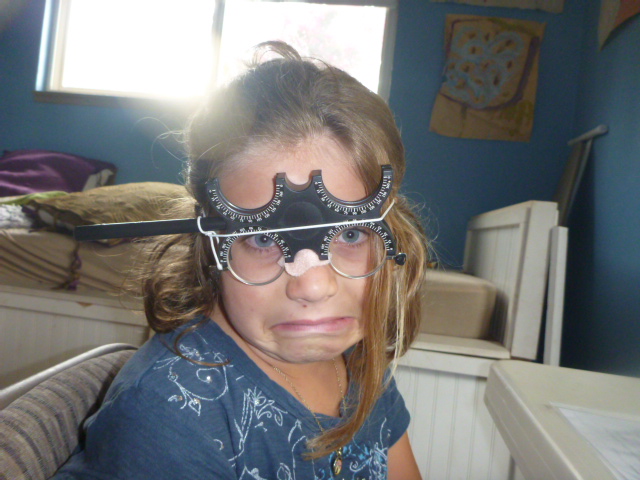Believe it or not, Alli LOVES this picture.
I wanted her to smile and she said ABSOLUTELY NOT!!! This is how she feels about these lenses.
So many exciting things have happened it is hard to keep track. I wish I had stayed more up to date on everything because I am planning to fight our insurance and I want as much ammunition as possible.
So, if Alli had broken her arm and needed physical therapy to repair her arm muscle, our insurance would pay 100%, but for some reason her eye muscles are not covered. I found that Aetna insurance does cover Vision Therapy, so now I am putting together a file of evidence as to why Blue Cross needs to support Vision Therapy also. Wish me luck, I will need it!!
Onto the improvements..... below are two pictures from the test for form constancy that Alli was given back in March (off the internet so not the best clarity).
You have to find the shape at the top in one of the images on the bottom. It can be bigger or smaller or rotated, but must maintain the same shape. Alli tested < 1% in March.......
.jpg) |
She was retested last week and scored > 99%.
Later that night I was telling my dad this and Alli asked what 99% meant and I said that if 100 kids were given this test, you scored higher than 99 of them. She said, "What about the other 1?" I said THAT IS YOU!!!!
Dr. Griffith agreed with what I have been saying for two years - Alli has had the ABILITY to do all of this: read, write, spell, jigsaw puzzles, catching a ball, etc....but her poor visual skills were getting in the way. I always thought Alli's eye muscles were weak, but Dr Griffith stated it this way:
"Our eye muscles are actually very strong, but the ability to use them well, in an efficient, precisely accurate, and coordinated manner can be poor. This has a lot to do with neurological pathways."
When I asked Dr. Griffith about if fixing the vision skills can fix Alli's reading problems she explains it this way:
"My approach is that there are many factors...vision is a very important one, and if there are any visual skill deficiencies, it is good to improve these and remove vision as a confounding factor and hurdle to learning to read. I do acknowledge that there are other factors that determine how a child can read...auditory, language, neurological, dyslexia (in a brain organization sense). "
Now I understand more clearly why the therapy that Alli and I have been doing has involved such a diverse range of activities. We did some bilateral movement activities (the circles on the board with both hands), lots of fine motor activities, some activities involving left and right movement, and some auditory activities out of "HELPING CHILDREN OVERCOME LEARNING DIFFICULTIES". All of these things have played a part in helping Alli learn to read.
When I asked Dr. Griffith about if fixing the vision skills can fix Alli's reading problems she explains it this way:
"My approach is that there are many factors...vision is a very important one, and if there are any visual skill deficiencies, it is good to improve these and remove vision as a confounding factor and hurdle to learning to read. I do acknowledge that there are other factors that determine how a child can read...auditory, language, neurological, dyslexia (in a brain organization sense). "
Now I understand more clearly why the therapy that Alli and I have been doing has involved such a diverse range of activities. We did some bilateral movement activities (the circles on the board with both hands), lots of fine motor activities, some activities involving left and right movement, and some auditory activities out of "HELPING CHILDREN OVERCOME LEARNING DIFFICULTIES". All of these things have played a part in helping Alli learn to read.
Friday she had her 12th appointment and Dr. Griffith redid an activity from the first week using this chart:
Alli had to wear the patch and read the first and last letters in each row.
Week 1 she took 72 seconds and had 3 errors. This week it took her 22 seconds!!!
Then she switched her patch to the other eye and read the second letters in on each side - so F H B R.
Week 1 this took her 132 seconds and had so many errors it wasnt tracked. This week it took her 30 seconds with 1 error
Finally, using both eyes she had to read the third in from each side so - N C A L.
Week 1 she could not even do this activity it was so difficult for her. This week she did it in 38 seconds with 1 error.
Amazing! We could not be happier. Alli has started a book called "How my eyes have improved" She is so excited. We are going to have a huge party when she is all done!!! It is so exciting to think about how far she has come.

.jpg)

I'm thankful we have Aetna and that has paid some for my daughter's vt. she developed ci after lyme (or maybe it made it worse..not sure)..vt has been a miracle for her too
ReplyDeleteLOVE this info. THANKS!!! WE NEED IT!
ReplyDelete